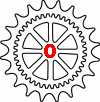|
Chain (or belt) & Sprocket wear influences:
Number
of contacts between chain & sprocket

When you
change one or both sprockets, you probably won't drive your bike less
or more miles to compensate....
When you mount a smaller front sprocket
and keep your rear sprocket, the front has to rotate more for every mile
you drive. The more it rotates, the more the individual teeth have
contact with a link and the more it wears out.
Let say
you have a 15 teeth front, a 36 teeth rear and 94 links on a 190/50/17
rear tire. Now for every mile you drive, the rear wheel has to rotate
about 824 times. This means your rear sprocket rotates 824 times. This
causes 824 * 36 = 29664 links to be transported to the front sprocket. So
the front sprocket will have to rotate about 29664 / 15 = 1977 times for
every mile you drive !
Now you change to a 14 teeth front sprocket and keep the rear and the
chain but switched to a 180/55/17 tire.
For every mile the rear now has to rotate 813 times (tire is less wide
but has a bigger circumference), transporting 813 * 36 = 29268 links to the front. Now this time it has to
rotate even more: 29268 / 14 = 2092 times for every mile! That is 114
(rounded) contact per mile extra, in percent that is 5.78%. (Not so odd
because that is the percentage the ratio changed as well !)


So what
the 'tooth - link contacts' table shows, is the number of contacts
per mile or per kilometer between:
- a Front sprocket tooth
comes in contact with a chain link
- a Rear sprocket tooth
comes in contact with a chain link
- a chain link comes
in contact with a sprocket tooth (both front and rear).
This is shown
for all 3 setups (hence
relative) and does not indicated the absolute amount
of wear.
I admit it is kind of hard to grasp....
Next: Fill out 'Add New
Bike"-mail form
Back to Gearing
Commander main page |








